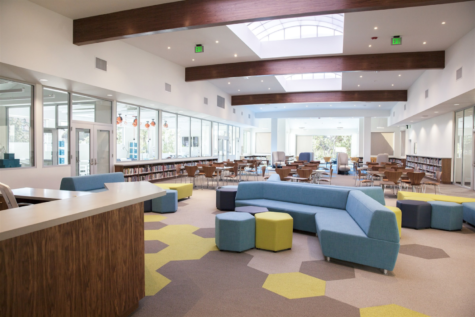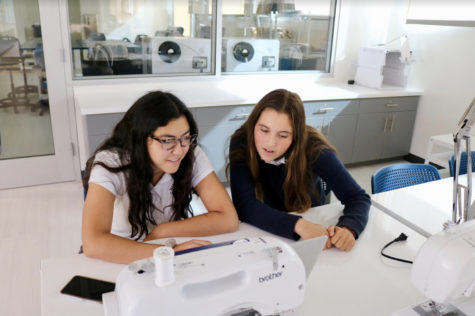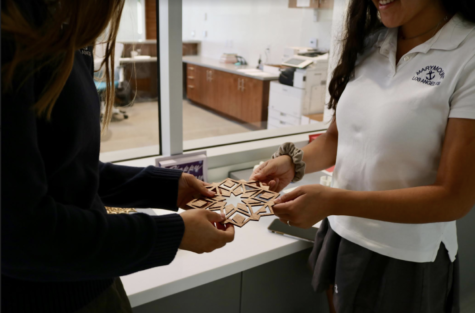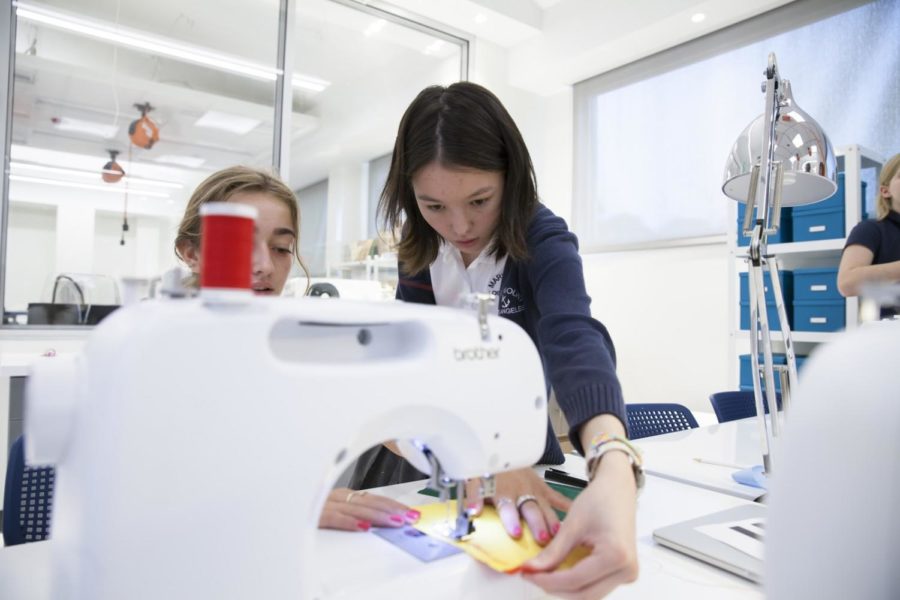How to Utilize the M3 Studio and DRC
October 15, 2018
On Monday, January 29th, 2018, Marymount opened its long-awaited Digital Resource Center (DRC). This newly transformed library is a space where students can come to study and work collaboratively. The DRC houses an M3 Studio (formerly known as the Makerspace), which contains 3D Printers, laser cutters, and many more tools for engineering and design. Many Marymount students are very interested in the M3 Studio and would like to better utilize the DRC, but are not sure of how to get involved. I interviewed Mr. Skrentny, Marymount’s M3 Studio Coordinator and Director of Design Engineering and Academic Data, to let people know where/how to start and what to expect when working in the M3 Studio, along with examples of fun things that everyone can design and create.

Sophia Scott: What is the M3 Studio? How can students go about getting started in using the M3 Studio?
Mr. Skrentny: The M3 Studio is an interdisciplinary space open to all students and classes who are interested in making, design, engineering, and more. It is a place to explore your creativity and turn ideas into reality. You can think of the space as a wood shop, robotics lab, art space, fashion studio, and technology center all rolled up into one. It is a collaborative and flexible space that breaks down the barriers between disciplines so that skills and ideas can cross-pollinate. The M3 Studio provides 3d printers, laser cutters, sewing machines, a large format printer, and a wide array of tools and supplies for students to create. These resources help you digitally design for the physical world while strengthening critical thinking skills.
Students can get involved in a variety of ways. Teachers of core classes schedule use of the space for class projects, for example the Physics classes have an open-ended design project where students frequent the space to realize designs that demonstrate a principle of physics. Algebra and Geometry utilize the 3d printers and laser cutters every year to strengthen existing projects. Visual Arts and Ceramics explore ways that new technology can be used for creativity by creating rubber stamp monograms, laser-cut earrings, 3d-printed molds for chocolate, and more! The room is also open throughout the day for students to utilize during their flex period to explore their interests or to work on an assignment.

Sophia Scott: What kind of things can be designed and created in the M3 Studio? How can students start designing or making them?
Mr. Skrentny: It would be impossible to create a list of what can be created in M3 Studio. The best creations are new concepts or ideas that synthesize existing elements in innovative and exciting ways. What is most important is the process, if you have an idea, it doesn’t matter if it is perfect in the end or if it even works! The learning happens through the mistakes and iterations. The difficulties you experience in the design process challenge you to think differently and force you to adapt. These adaptations can lead to a new perspective and allow you to look at your concept from a new angle. All that is needed to start designing or making is willingness to dive-in. You will discover what you need to learn along the way! Students can visit the M3 Studio with as little as the seed of an idea or the desire to learn something new.

Sophia Scott: Do students need to know how to use a 3D printer or laser cutter to come to the M3 Studio? Can students get assistance when they come? When is the M3 Studio open?
Mr. Skrentny: Students do not need to know how to use a 3d printer or laser cutter before visiting the M3 Studio. If you are interested you are welcome, and I am happy to help point students in the right direction to get started. Faculty that work in the space are like mentors or consultants, you can bounce your ideas off the wall and have conversations to see what makes sense and to develop a plan of action. M3 is open throughout the day so you can use the space to work on your own or with friends. The fabrication room is locked unless there is a faculty member present for safety purposes. I spend about 80-90% of my time in the DRC. You can always schedule an appointment with me if you are interested in meeting to discuss an idea or learn new skills.
Sophia Scott: What tools/machines are available in the Makerspace? How can students learn to use them?
Mr. Skrentny: The following is a list of equipment, tools, and regularly stocked supplies that we have available:
| Art Supplies
Acrylic Paint Brushes Colored Pencils Crayons Gesso Magnets Pens Sculpting Tools |
Electronic Supplies
AC Power Batteries Conductive Tape, Thread, Ink Electrical Wire Heat Shrink Tubing LEDs Microcontrollers Sensors Servos |
Adhesive Supplies
Clear Tape Double Sided Tape Duck Tape E6000 Foam Tape Elmer’s Glue Hot Glue Mod Podge Painter’s Tape Rubber Cement Spray Adhesive Super Glue Wood Glue |
| Construction Supplies
Hooks Nails Nuts Screws Staples Washers Wire |
Craft Supplies
Cork Dowel Rods Feathers Mirror Pieces Pipe Cleaners Pom Poms Rubber Bands Styrofoam Balls |
Flat Materials
Acrylic Basswood Birch Plywood Canvas Paper Cardboard Cardstock Chipboard Construction Paper Craft Foam Drawing Paper Foam Board Laser Engravable Rubber Tracing Paper |
| Textile Supplies
Awls D-Rings Dressmaker’s Shears Embroidery Scissors Elastic Eyelet Pliers Fabric Dye Fabric Markers Inkodye Marking Utensils Needles Nylon Straps Nylon Thread Pin Cushion Pins Polyester Thread Seam Rippers Tweezers Velcro |
General Tools
3D Pens Dremel Rotary Tools and Attachments Heat Guns Hole Punchers Hot Glue Guns Fabric Iron Files Pliers Power Drill PVC Cutters Razor Blades Rotary Cutters Scales Screwdrivers Self-Healing Mat Soldering Irons Staple Gun Tin Snips Wire Cutters |
Equipment
Belt and Disc Sander Airwolf AXIOM 3D Printers Brother Sewing Machines Epic Pro 27” Laminator Epson Stylus Pro 24” HDR Printer 45W Full Spectrum Laser Cutters iSense 3D Scanners and iPad Air MakerBot Replicator 2X 3D Printers 40” Paper and Foam Board Trimmer |
Sophia Scott: What are some of the most interesting things that students have made in the M3 Studio? Is there anything new this year?
Mr. Skrentny: A few of my favorite projects have come from the Physics end-of-year projects and include: an infrared pet food dispenser (using the laser cutter, 3d printer, electronics), a small-scale Jane’s Ladder (a Jacob’s ladder using the laser cutter, electronics, and soldering), a rainbow flashlight (using the laser cutter, electronics, and light refraction), and 3d-printed polarized sunglasses. Spanish IV Honors recently used the space to sew flags of Spanish-speaking South American countries. Intro to Computer Science is currently 3D-printing name tags designed in SketchUp.



